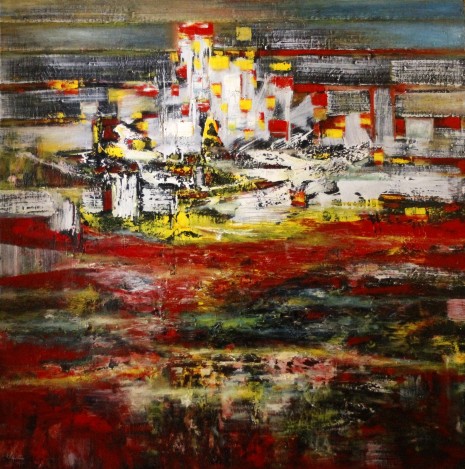The exhibition “Vision II” is the reflection of a seasoned artist, Chhim Sothy, on his country’s abiding poverty set against its manifest prosperity.
“You may have a multistory building rising tall and, on the street below, people with no home and job sleeping around it,” said the painter.
There is no denying the benefits of economic progress made in the country, but the apparent affluence in Phnom Penh tends to obscure widespread impoverishment experienced by many Cambodians, he said.
In his exhibition being held at Phnom Penh’s Tamarind Restaurant, Mr. Sothy has used two patently different styles and techniques to express the dichotomy between Phnom Penh’s façade of prosperity and its poor: the first expressed in light-color abstracts done in broad strokes sometimes with paint knives, the second shown in somber figurative works whose details are carefully drawn and colored with paint brushes.
In the abstract “Red City,” a cityscape of high-rises appears in the distance with an ocean of red, yellow and black below. “The color red is strength, heat, audacity, courage,” Mr. Sothy said. “’Red City’ is about the city growing, its feverish activity and development projects but also evictions.”
In the figurative painting “My Family,” a boy wipes his brow with his arm, exhausted, while around him emaciated people rummage through garbage and a woman wearing a krama, old before her time, pauses for a moment. Done in ochre and blue-grey tones, the work is a reminder of the hardships imposed upon people who scavenge through garbage for a living.
“Big Brother” is a powerful depiction of crime and the abuse of power in society: men in shirts and ties, one with a bandanna and a revolver, women clothed and naked embroiled in these men’s deals and, in the distance, a street person carrying his belongings on his shoulder. Sketched in straight black lines against grey and brown hues, the painting depicts those people who feel free to run illegal activities, being protected by influential individuals.
Mr. Sothy’s series on the city’s ills also includes “Morality and Stomach” in which haunting figures appear out of a nebulous background, expressing the fact that a person may resort to reprehensible acts when starving, he explained. “Abiding by moral principles is easy when one has comfort, a home and ample food to eat,” he said. “But when one is hungry, he may end up stealing to survive.”
And there is the painting “Memory,” a reminder that a great many Cambodians remain haunted by images of war and killings. The work is dominated by a skin-and-bones man covering his face with his hands as, above him, soldiers beat a person, dead bodies scattered on the ground below.
Mr. Sothy is part of the first generation of visual artists to graduate from the Royal University of Fine Arts (RUFA) in the mid-1990s, along with Leang Seckon. His paintings have been exhibited in France, the United States, Singapore and several other Southeast Asian countries. Moreover, his work was selected by the jury of the Beijing International Art Biennale to represent Cambodia in 2008, 2010 and 2012.
Born in 1969, Mr. Sothy spent the Khmer Rouge regime in Pursat province—his father, who was a district chief in the early 1970s, was killed early on in the Pol Pot regime while his mother survived.
Admitted to RUFA in 1985, he graduated in 1995, and soon built a reputation for reinventing Cambodian traditional painting by placing characters from the Reamker—the country’s version of the Indian epic tale Ramayana—on abstract, contemporary backgrounds.
However in the mid-2000s, Mr. Sothy, who is deputy director of Fine Arts and Handicrafts at the Ministry of Culture, set aside traditional painting to turn to abstract and contemporary styles.
One of Mr. Sothy’s reasons for depicting Cambodia’s development in abstract in his series “Vision II” is his own uncertainty as to where it will lead the country, he said.
Whatever style he chooses to use, Mr. Sothy’s paintings tend to be complex works in which the smallest detail or touch of color contains a world of meaning, said Yves Narin who curated the exhibition and has known the artist since the 1990s.
“The country’s reality is not all black or all white,” he said. “So the exhibition had to reflect these two visions: the dark side and the utopian one.”
The exhibition at Tamarind Restaurant, which is located at 31 Street 240, is being shown through July.
